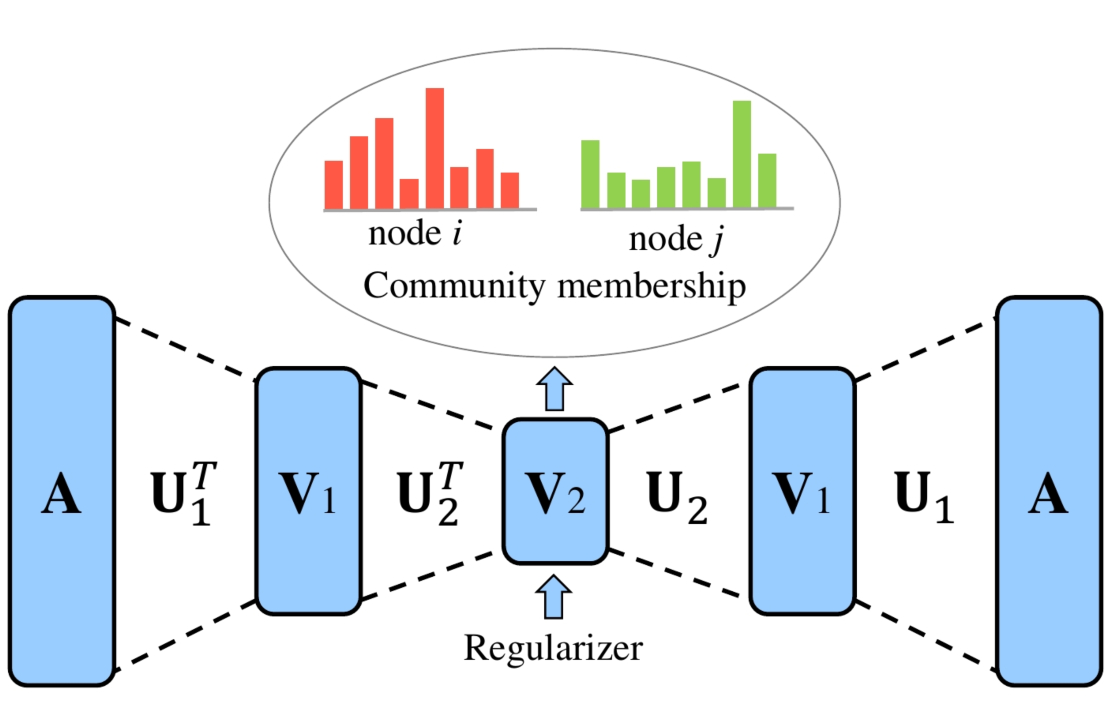benedekrozemberczki / Danmf
Programming Languages
Labels
Projects that are alternatives of or similar to Danmf
DANMF
An implementation of Deep Autoencoder-like Nonnegative Matrix Factorization for Community Detection (CIKM 2018).
Abstract
Community structure is ubiquitous in real-world complex networks. The task of community detection over these networks is of paramount importance in a variety of applications. Recently, nonnegative matrix factorization (NMF) has been widely adopted for community detection due to its great interpretability and its natural fitness for capturing the community membership of nodes. However, the existing NMF-based community detection approaches are shallow methods. They learn the community assignment by mapping the original network to the community membership space directly. Considering the complicated and diversified topology structures of real-world networks, it is highly possible that the mapping between the original network and the community membership space contains rather complex hierarchical information, which cannot be interpreted by classic shallow NMF-based approaches. Inspired by the unique feature representation learning capability of deep autoencoder, we propose a novel model, named Deep Autoencoder-like NMF (DANMF), for community detection. Similar to deep autoencoder, DANMF consists of an encoder component and a decoder component. This architecture empowers DANMF to learn the hierarchical mappings between the original network and the final community assignment with implicit low-to-high level hidden attributes of the original network learnt in the intermediate layers. Thus, DANMF should be better suited to the community detection task. Extensive experiments on benchmark datasets demonstrate that DANMF can achieve better performance than the state-of-the-art NMF-based community detection approaches.
The model is now also available in the package Karate Club.
This repository provides an implementation for DANMF as described in the paper:
Deep Autoencoder-like Nonnegative Matrix Factorization for Community Detection. Fanghua Ye, Chuan Chen, and Zibin Zheng. CIKM, 2018. [Paper]
A MatLab reference implementation is available [here].
Requirements
The codebase is implemented in Python 3.5.2. package versions used for development are just below.
networkx 1.11
tqdm 4.28.1
numpy 1.15.4
pandas 0.23.4
texttable 1.5.0
scipy 1.1.0
argparse 1.1.0
sklearn 0.20.0
Datasets
The code takes an input graph in a csv file. Every row indicates an edge between two nodes separated by a comma. The first row is a header. Nodes should be indexed starting with 0. Sample graphs for the `Twitch Brasilians` ,`Wikipedia Chameleons` and `Wikipedia Giraffes` are included in the `input/` directory.
Options
Learning of the embedding is handled by the `src/main.py` script which provides the following command line arguments.
Input and output options
--edge-path STR Input graph path. Default is `input/ptbr_edges.csv`.
--membership-path STR Membership path. Default is `output/ptbr_membership.json`.
--output-path STR Embedding path. Default is `output/ptbr_danmf.csv`.
Model options
--iterations INT Number of epochs. Default is 100.
--pre-iterations INT Layer-wise epochs. Default is 100.
--seed INT Random seed value. Default is 42.
--lamb FLOAT Regularization parameter. Default is 0.01.
--layers LST Layer sizes in autoencoder model. Default is [32, 8]
--calculate-loss BOOL Loss calculation for the model. Default is False.
Examples
The following commands learn a graph embedding and write this embedding to disk. The node representations are ordered by node identifiers. Layer sizes are always set manually.
Creating a DANMF embedding of the default dataset with a 128-64-32-16 architecture. Saving the embedding at the default path.
python src/main.py --layers 128 64 32 16
Creating a DANMF embedding of the default dataset with a 96-8 architecture and calculationg the loss.
python src/main.py --layers 96 8 --calculate-loss
Creating a single layer DANMF embedding with 32 factors.
python src/main.py --layers 32
Creating an embedding with some custom cluster number in the bottleneck layer.
python src/main.py --layers 128 64 7
Creating an embedding of another dataset the Wikipedia Chameleons. Saving the output in a custom folder.
python src/main.py --layers 32 8 --edge-path input/chameleon_edges.csv --output-path output/chameleon_danmf.csv --membership-path output/chameleon_membership.json
License



